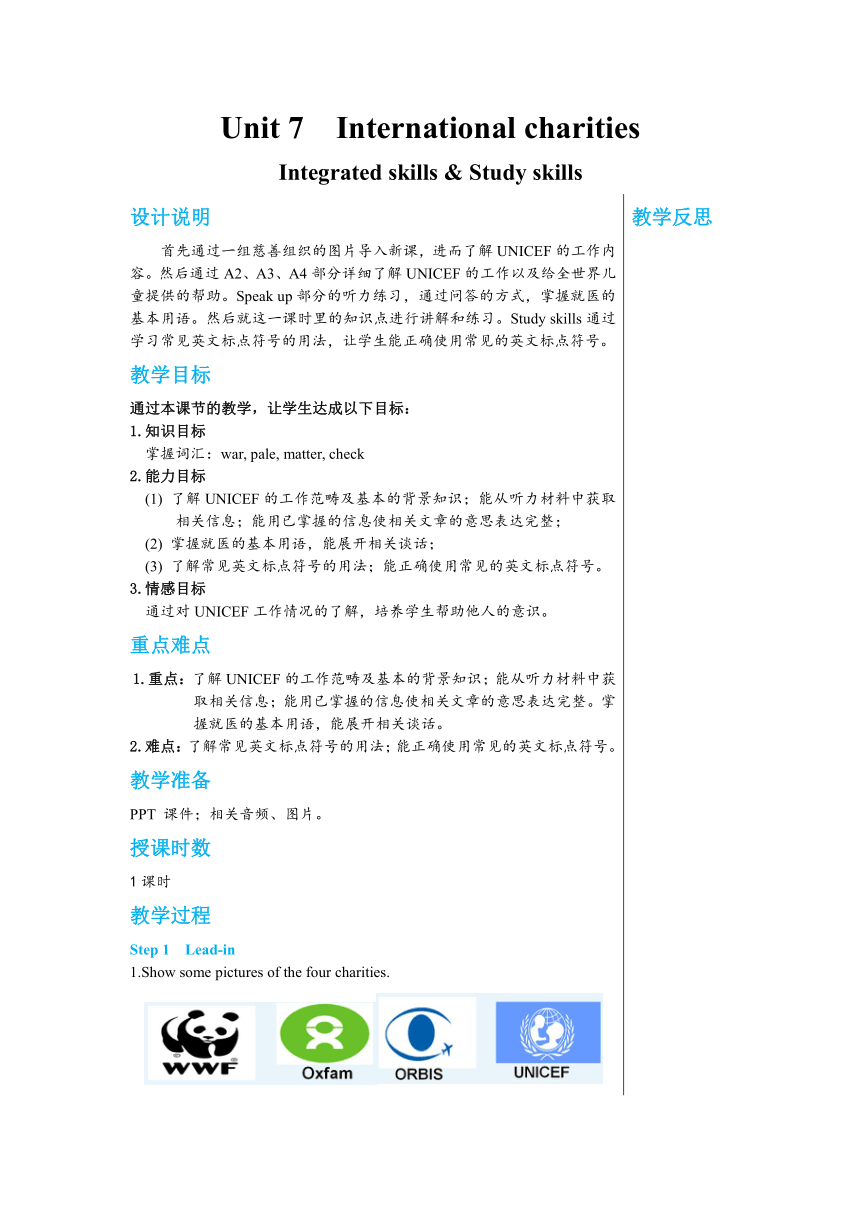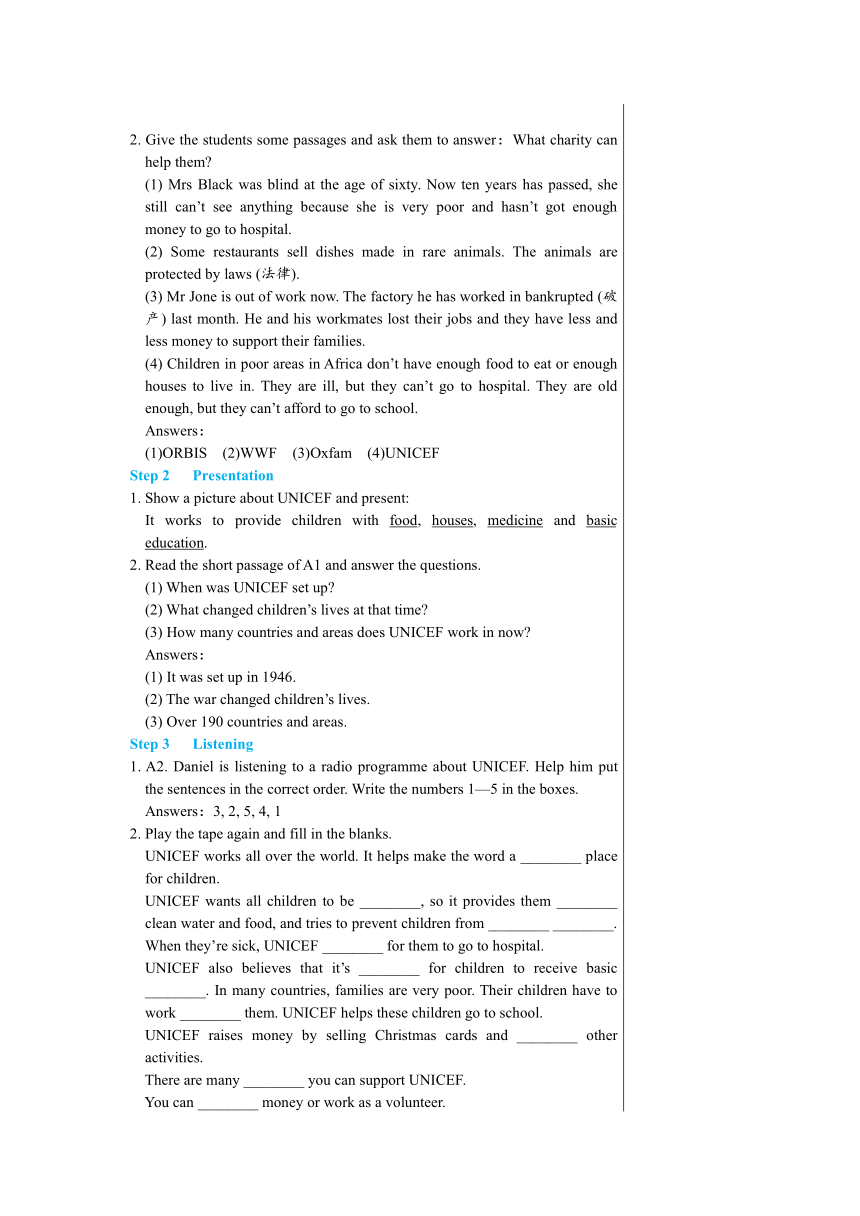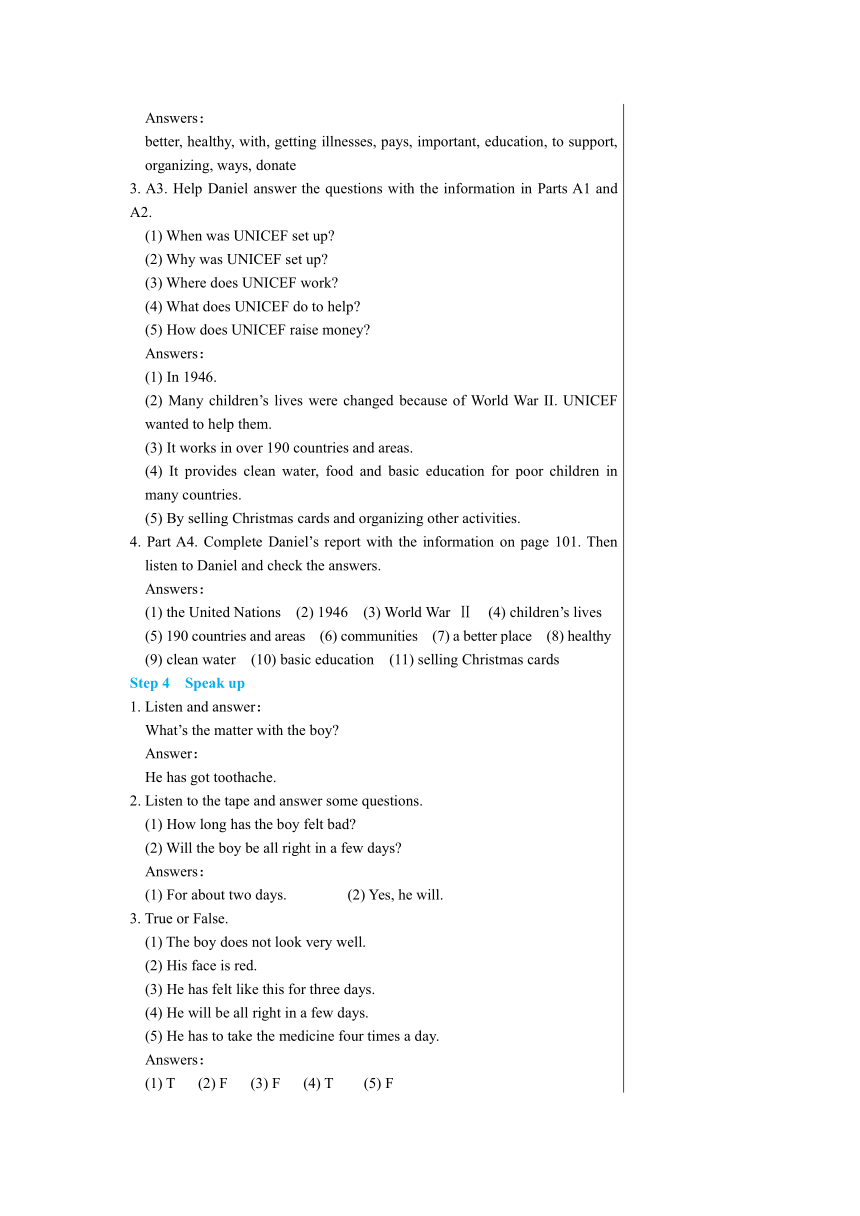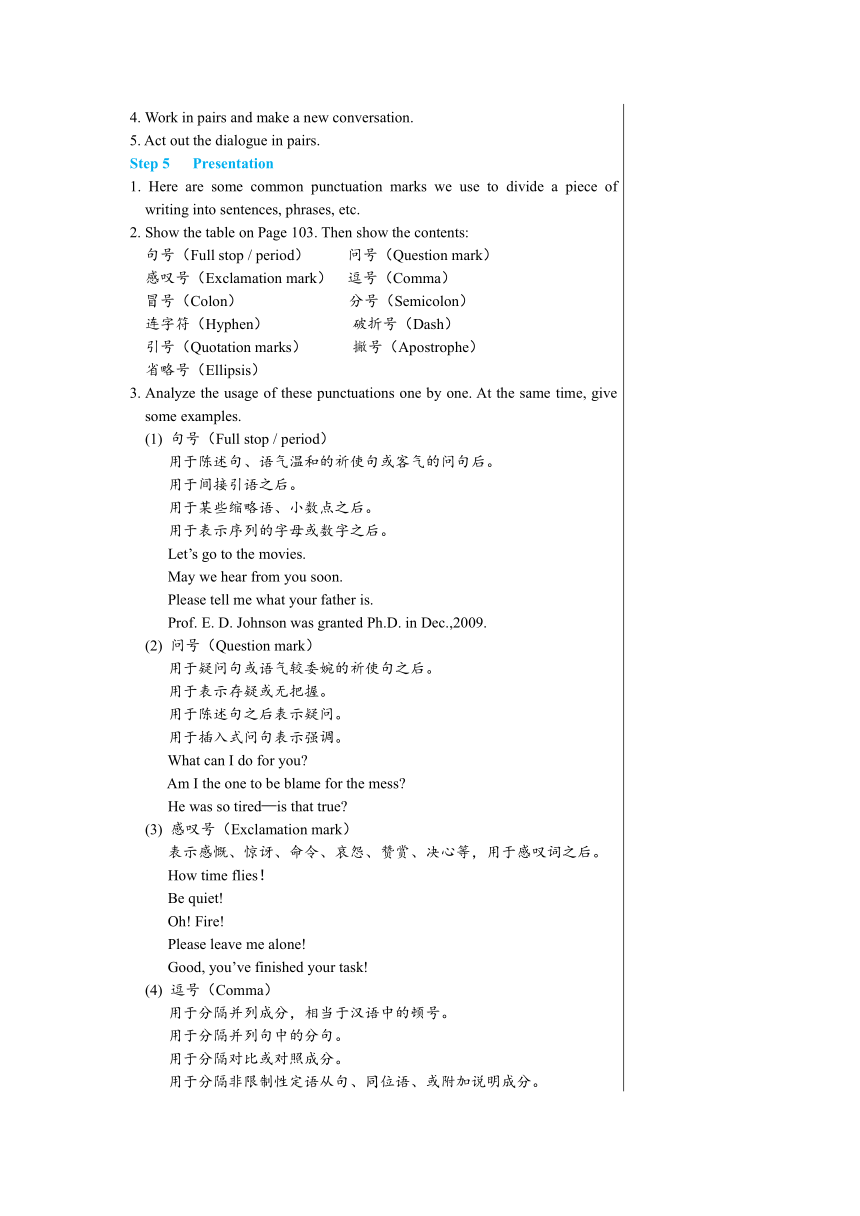Unit 7 Integrated skills & Study skills教学详案--牛津译林版中学英语八年级下
文档属性
| 名称 | Unit 7 Integrated skills & Study skills教学详案--牛津译林版中学英语八年级下 |  | |
| 格式 | docx | ||
| 文件大小 | 102.3KB | ||
| 资源类型 | 试卷 | ||
| 版本资源 | 牛津译林版 | ||
| 科目 | 英语 | ||
| 更新时间 | 2024-02-21 19:41:09 | ||
图片预览




文档简介
Unit 7 International charities
Integrated skills & Study skills
设计说明 首先通过一组慈善组织的图片导入新课,进而了解UNICEF的工作内容。然后通过A2、A3、A4部分详细了解UNICEF的工作以及给全世界儿童提供的帮助。Speak up部分的听力练习,通过问答的方式,掌握就医的基本用语。然后就这一课时里的知识点进行讲解和练习。Study skills通过学习常见英文标点符号的用法,让学生能正确使用常见的英文标点符号。 教学目标 通过本课节的教学,让学生达成以下目标: 1.知识目标 掌握词汇:war, pale, matter, check 2.能力目标 (1) 了解UNICEF的工作范畴及基本的背景知识;能从听力材料中获取相关信息;能用已掌握的信息使相关文章的意思表达完整; (2) 掌握就医的基本用语,能展开相关谈话; (3) 了解常见英文标点符号的用法;能正确使用常见的英文标点符号。 3.情感目标 通过对UNICEF工作情况的了解,培养学生帮助他人的意识。 重点难点 1.重点:了解UNICEF的工作范畴及基本的背景知识;能从听力材料中获取相关信息;能用已掌握的信息使相关文章的意思表达完整。掌握就医的基本用语,能展开相关谈话。 2.难点:了解常见英文标点符号的用法;能正确使用常见的英文标点符号。 教学准备 PPT 课件;相关音频、图片。 授课时数 1课时 教学过程 Step 1 Lead-in 1.Show some pictures of the four charities. 2. Give the students some passages and ask them to answer:What charity can help them (1) Mrs Black was blind at the age of sixty. Now ten years has passed, she still can’t see anything because she is very poor and hasn’t got enough money to go to hospital. (2) Some restaurants sell dishes made in rare animals. The animals are protected by laws (法律). (3) Mr Jone is out of work now. The factory he has worked in bankrupted (破产) last month. He and his workmates lost their jobs and they have less and less money to support their families. (4) Children in poor areas in Africa don’t have enough food to eat or enough houses to live in. They are ill, but they can’t go to hospital. They are old enough, but they can’t afford to go to school. Answers: (1)ORBIS (2)WWF (3)Oxfam (4)UNICEF Step 2 Presentation 1. Show a picture about UNICEF and present: It works to provide children with food, houses, medicine and basic education. 2. Read the short passage of A1 and answer the questions. (1) When was UNICEF set up (2) What changed children’s lives at that time (3) How many countries and areas does UNICEF work in now Answers: (1) It was set up in 1946. (2) The war changed children’s lives. (3) Over 190 countries and areas. Step 3 Listening 1. A2. Daniel is listening to a radio programme about UNICEF. Help him put the sentences in the correct order. Write the numbers 1—5 in the boxes. Answers:3, 2, 5, 4, 1 2. Play the tape again and fill in the blanks. UNICEF works all over the world. It helps make the word a ________ place for children. UNICEF wants all children to be ________, so it provides them ________ clean water and food, and tries to prevent children from ________ ________. When they’re sick, UNICEF ________ for them to go to hospital. UNICEF also believes that it’s ________ for children to receive basic ________. In many countries, families are very poor. Their children have to work ________ them. UNICEF helps these children go to school. UNICEF raises money by selling Christmas cards and ________ other activities. There are many ________ you can support UNICEF. You can ________ money or work as a volunteer. Answers: better, healthy, with, getting illnesses, pays, important, education, to support, organizing, ways, donate 3. A3. Help Daniel answer the questions with the information in Parts A1 and A2. (1) When was UNICEF set up (2) Why was UNICEF set up (3) Where does UNICEF work (4) What does UNICEF do to help (5) How does UNICEF raise money Answers: (1) In 1946. (2) Many children’s lives were changed because of World War II. UNICEF wanted to help them. (3) It works in over 190 countries and areas. (4) It provides clean water, food and basic education for poor children in many countries. (5) By selling Christmas cards and organizing other activities. 4. Part plete Daniel’s report with the information on page 101. Then listen to Daniel and check the answers. Answers: (1) the United Nations (2) 1946 (3) World War Ⅱ (4) children’s lives (5) 190 countries and areas (6) communities (7) a better place (8) healthy (9) clean water (10) basic education (11) selling Christmas cards Step 4 Speak up 1. Listen and answer: What’s the matter with the boy Answer: He has got toothache. 2. Listen to the tape and answer some questions. (1) How long has the boy felt bad (2) Will the boy be all right in a few days Answers: (1) For about two days. (2) Yes, he will. 3. True or False. (1) The boy does not look very well. (2) His face is red. (3) He has felt like this for three days. (4) He will be all right in a few days. (5) He has to take the medicine four times a day. Answers: (1) T (2) F (3) F (4) T (5) F 4. Work in pairs and make a new conversation. 5. Act out the dialogue in pairs. Step 5 Presentation 1. Here are some common punctuation marks we use to divide a piece of writing into sentences, phrases, etc. 2. Show the table on Page 103. Then show the contents: 句号(Full stop / period) 问号(Question mark) 感叹号(Exclamation mark) 逗号(Comma) 冒号(Colon) 分号(Semicolon) 连字符(Hyphen) 破折号(Dash) 引号(Quotation marks) 撇号(Apostrophe) 省略号(Ellipsis) 3. Analyze the usage of these punctuations one by one. At the same time, give some examples. (1) 句号(Full stop / period) 用于陈述句、语气温和的祈使句或客气的问句后。 用于间接引语之后。 用于某些缩略语、小数点之后。 用于表示序列的字母或数字之后。 Let’s go to the movies. May we hear from you soon. Please tell me what your father is. Prof. E. D. Johnson was granted Ph.D. in Dec.,2009. (2) 问号(Question mark) 用于疑问句或语气较委婉的祈使句之后。 用于表示存疑或无把握。 用于陈述句之后表示疑问。 用于插入式问句表示强调。 What can I do for you Am I the one to be blame for the mess He was so tired—is that true (3) 感叹号(Exclamation mark) 表示感慨、惊讶、命令、哀怨、赞赏、决心等,用于感叹词之后。 How time flies! Be quiet! Oh! Fire! Please leave me alone! Good, you’ve finished your task! (4) 逗号(Comma) 用于分隔并列成分,相当于汉语中的顿号。 用于分隔并列句中的分句。 用于分隔对比或对照成分。 用于分隔非限制性定语从句、同位语、或附加说明成分。 用于分隔附加疑问句或选择疑问句。 用于分隔直接引语及导语。 用于分隔句首状语、插入语等。 用于分隔日期、数字、地点、人名与职衔、(信件)称呼语等。 We’re tired, thirsty and hungry. We must hurry up, otherwise, we will miss the bus. No pains, no gains. He wants you, him and me, to go to his place tomorrow. John didn’t take it, did he Mr Green said, “Please call on us.” Frankly, that’s all the money I have. He left on July 20, 2008, for a trip around the world. David Smith, Ph.D. (5) 冒号(Colon) 冒号用于对后面内容的介绍或解释。 用于一个正式的引用之前, 也可用于商业或正式信函的称谓后面。 冒号用于数字时间的表示。 冒号用于主标题和副标题之间。 This is her plan: go shopping. The professor said, “It was horrible.” 4:45 pm Web Directory: World and Non-US Economic Data (6) 分号(Semicolon) 用于并列分句之间。 分隔已经有逗号分隔的成分,以免导致歧义。 用于由for example, for instance, namely, that is (to say), in fact, i.e.等词语引导的句子之前。 Your bike is new; mine is old. Follow this procedure: first, get your application forms; next, fill them out; last, pay the charge. His sister is a busy girl; in fact, she works harder than he does. (7) 连字符(Hyphen) 用于某些前缀后构成复合词。 构成某些复合数字(100以下的数字应用单词写出,不可用阿拉伯数字代替) 用于移行, 一般按音节间断开的单词加连字号(例如:ha-ppy,不可断为hap-py……), 或根据发音,不要把单个字母留在行尾或行首。注意一页中最后一个单词不能使用连字号将其置于两页。 Job-hunting twenty-one during the years 1949-1999 (8) 破折号(Dash) 用于话语突然中断、意思转折或犹豫不决。 用作解释。 用于被强调部分。 用于引出概括性词语或表示引文出处。 用于两地名或两时间之间,相当于连字号。 “I’d like to,” he said, “but I’m—” Money, fame, power—these are his goals in life. What he needed most he never got—love. London—New York flight (9) 引号(Quotation marks) 引用书面或口头的直接引语。 引用俚语、反语、定义、词形等。 引用对话。 表示强调。 Bob said, “Let’s meet at my house next time.” How do you spell the word “souvenir” “Did you have a great time last night ” (10) 撇号(Apostrophe) 省字符。 表示某些特殊结构的复数形式。 表示名词的所有格。 you’d better = you had better today’s news, a friend of my father’s (11) 省略号(Ellipsis) 表示词语或句子的有意省略。 表示断断续续、停顿、犹豫不决。 表示没有说完的话语。 用以分隔词组,加强语气。 “…the book is lovely and well written.” “Tell … mother … I … died … for … my country.” Do it soon… Do it today … Do it now. “I don’t know… I don’t know.” 4. The differences between Chinese punctuations and English punctuations. (1) 汉语中的某些标点符号在英语中没有。 ① 顿号(、):顿号在汉语中起分割句子中的并列成分的作用;英语中没有顿号,分割句中的并列成分多用逗号。如: She slowly, carefully, deliberately moved the box. 注意:类似的情况下,最后一个逗号后可加and,这个逗号也可省略。 She slowly, carefully(,) and deliberately moved the box. ② 间隔号(·):汉语有间隔号,用在月份和日期、音译的名和姓等需要隔开的词语的正中间,如“一二·九”、“奥黛丽·赫本(人名)”等。英语中没有汉语的间隔号,需要间隔时多用逗号。 ③ 书名号(《》):英文没有书名号,书名、报刊名用斜体或者下划线表示。如:Hamlet 《哈姆雷特》 Winter’s Tale《冬天的童话》 另外,英语中文章、诗歌、乐曲、电影、绘画等的名称和交通工具、航天器等的专有名词也常用斜体来表示。 (2) 英语中的某些标点符号在汉语中没有。 ①撇号—Apostrophe(’) ②连字号—Hyphen(-) ③斜线号—Virgule or Slash(/):该符号主要起分隔作用。 It could be for staff and / or students. 也常用于音标,如bed /bed/。 (3) 某些符号在汉英两种语言中的形式不同。 ①中文的句号是空心圈(。)英文的句号是实心点(·)。 ②英文的省略号是三个点(...),位置在行底;中文的省略号为六个点(……),居于行中。 ③ 英文的破折号是(—)中文的是(——) Step 6 Practice A charity show. Help Millie add the correct punctuation marks. Answers: The big day came very quickly, and suddenly it was the night before the charity show. I could not sleep at all that night because I was so excited. “Will it be a success ” I kept asking myself. Twenty minutes before the big event, the doors opened and many people came into the theatre. “No time to be nervous any more. This is it!” I told myself. A lot of people came to watch the show. They were making a lot of noise, so I had to speak loudly. Step 7 Homework 1. Try to remember the new words and phrases in this part. 2. Revise the common punctuation marks and pay more attention to their usage(用法). 当堂达标 完成句子 1. 我们学校经常组织不同的活动。 Our school often ________ different ________. 2. 你怎么了? ________ ________ ________ with you 3. 他英语说得很好。 He ________ English very ________. 4. 你在上交试卷前应该检查一下。 You should ________ ________ ________ before you hand in your exam paper. 5. 几天后我将去上学。 I ________ ________ to school in a few days. Answers:1. organizes, activities 2.What’s the matter 3.speaks,well 4.have a check 5.will go 板书设计 Unit 7 International charities Integrated skills & Study skillsNew words: war pale matter check Phrases: work as a volunteer
教学反思
Integrated skills & Study skills
设计说明 首先通过一组慈善组织的图片导入新课,进而了解UNICEF的工作内容。然后通过A2、A3、A4部分详细了解UNICEF的工作以及给全世界儿童提供的帮助。Speak up部分的听力练习,通过问答的方式,掌握就医的基本用语。然后就这一课时里的知识点进行讲解和练习。Study skills通过学习常见英文标点符号的用法,让学生能正确使用常见的英文标点符号。 教学目标 通过本课节的教学,让学生达成以下目标: 1.知识目标 掌握词汇:war, pale, matter, check 2.能力目标 (1) 了解UNICEF的工作范畴及基本的背景知识;能从听力材料中获取相关信息;能用已掌握的信息使相关文章的意思表达完整; (2) 掌握就医的基本用语,能展开相关谈话; (3) 了解常见英文标点符号的用法;能正确使用常见的英文标点符号。 3.情感目标 通过对UNICEF工作情况的了解,培养学生帮助他人的意识。 重点难点 1.重点:了解UNICEF的工作范畴及基本的背景知识;能从听力材料中获取相关信息;能用已掌握的信息使相关文章的意思表达完整。掌握就医的基本用语,能展开相关谈话。 2.难点:了解常见英文标点符号的用法;能正确使用常见的英文标点符号。 教学准备 PPT 课件;相关音频、图片。 授课时数 1课时 教学过程 Step 1 Lead-in 1.Show some pictures of the four charities. 2. Give the students some passages and ask them to answer:What charity can help them (1) Mrs Black was blind at the age of sixty. Now ten years has passed, she still can’t see anything because she is very poor and hasn’t got enough money to go to hospital. (2) Some restaurants sell dishes made in rare animals. The animals are protected by laws (法律). (3) Mr Jone is out of work now. The factory he has worked in bankrupted (破产) last month. He and his workmates lost their jobs and they have less and less money to support their families. (4) Children in poor areas in Africa don’t have enough food to eat or enough houses to live in. They are ill, but they can’t go to hospital. They are old enough, but they can’t afford to go to school. Answers: (1)ORBIS (2)WWF (3)Oxfam (4)UNICEF Step 2 Presentation 1. Show a picture about UNICEF and present: It works to provide children with food, houses, medicine and basic education. 2. Read the short passage of A1 and answer the questions. (1) When was UNICEF set up (2) What changed children’s lives at that time (3) How many countries and areas does UNICEF work in now Answers: (1) It was set up in 1946. (2) The war changed children’s lives. (3) Over 190 countries and areas. Step 3 Listening 1. A2. Daniel is listening to a radio programme about UNICEF. Help him put the sentences in the correct order. Write the numbers 1—5 in the boxes. Answers:3, 2, 5, 4, 1 2. Play the tape again and fill in the blanks. UNICEF works all over the world. It helps make the word a ________ place for children. UNICEF wants all children to be ________, so it provides them ________ clean water and food, and tries to prevent children from ________ ________. When they’re sick, UNICEF ________ for them to go to hospital. UNICEF also believes that it’s ________ for children to receive basic ________. In many countries, families are very poor. Their children have to work ________ them. UNICEF helps these children go to school. UNICEF raises money by selling Christmas cards and ________ other activities. There are many ________ you can support UNICEF. You can ________ money or work as a volunteer. Answers: better, healthy, with, getting illnesses, pays, important, education, to support, organizing, ways, donate 3. A3. Help Daniel answer the questions with the information in Parts A1 and A2. (1) When was UNICEF set up (2) Why was UNICEF set up (3) Where does UNICEF work (4) What does UNICEF do to help (5) How does UNICEF raise money Answers: (1) In 1946. (2) Many children’s lives were changed because of World War II. UNICEF wanted to help them. (3) It works in over 190 countries and areas. (4) It provides clean water, food and basic education for poor children in many countries. (5) By selling Christmas cards and organizing other activities. 4. Part plete Daniel’s report with the information on page 101. Then listen to Daniel and check the answers. Answers: (1) the United Nations (2) 1946 (3) World War Ⅱ (4) children’s lives (5) 190 countries and areas (6) communities (7) a better place (8) healthy (9) clean water (10) basic education (11) selling Christmas cards Step 4 Speak up 1. Listen and answer: What’s the matter with the boy Answer: He has got toothache. 2. Listen to the tape and answer some questions. (1) How long has the boy felt bad (2) Will the boy be all right in a few days Answers: (1) For about two days. (2) Yes, he will. 3. True or False. (1) The boy does not look very well. (2) His face is red. (3) He has felt like this for three days. (4) He will be all right in a few days. (5) He has to take the medicine four times a day. Answers: (1) T (2) F (3) F (4) T (5) F 4. Work in pairs and make a new conversation. 5. Act out the dialogue in pairs. Step 5 Presentation 1. Here are some common punctuation marks we use to divide a piece of writing into sentences, phrases, etc. 2. Show the table on Page 103. Then show the contents: 句号(Full stop / period) 问号(Question mark) 感叹号(Exclamation mark) 逗号(Comma) 冒号(Colon) 分号(Semicolon) 连字符(Hyphen) 破折号(Dash) 引号(Quotation marks) 撇号(Apostrophe) 省略号(Ellipsis) 3. Analyze the usage of these punctuations one by one. At the same time, give some examples. (1) 句号(Full stop / period) 用于陈述句、语气温和的祈使句或客气的问句后。 用于间接引语之后。 用于某些缩略语、小数点之后。 用于表示序列的字母或数字之后。 Let’s go to the movies. May we hear from you soon. Please tell me what your father is. Prof. E. D. Johnson was granted Ph.D. in Dec.,2009. (2) 问号(Question mark) 用于疑问句或语气较委婉的祈使句之后。 用于表示存疑或无把握。 用于陈述句之后表示疑问。 用于插入式问句表示强调。 What can I do for you Am I the one to be blame for the mess He was so tired—is that true (3) 感叹号(Exclamation mark) 表示感慨、惊讶、命令、哀怨、赞赏、决心等,用于感叹词之后。 How time flies! Be quiet! Oh! Fire! Please leave me alone! Good, you’ve finished your task! (4) 逗号(Comma) 用于分隔并列成分,相当于汉语中的顿号。 用于分隔并列句中的分句。 用于分隔对比或对照成分。 用于分隔非限制性定语从句、同位语、或附加说明成分。 用于分隔附加疑问句或选择疑问句。 用于分隔直接引语及导语。 用于分隔句首状语、插入语等。 用于分隔日期、数字、地点、人名与职衔、(信件)称呼语等。 We’re tired, thirsty and hungry. We must hurry up, otherwise, we will miss the bus. No pains, no gains. He wants you, him and me, to go to his place tomorrow. John didn’t take it, did he Mr Green said, “Please call on us.” Frankly, that’s all the money I have. He left on July 20, 2008, for a trip around the world. David Smith, Ph.D. (5) 冒号(Colon) 冒号用于对后面内容的介绍或解释。 用于一个正式的引用之前, 也可用于商业或正式信函的称谓后面。 冒号用于数字时间的表示。 冒号用于主标题和副标题之间。 This is her plan: go shopping. The professor said, “It was horrible.” 4:45 pm Web Directory: World and Non-US Economic Data (6) 分号(Semicolon) 用于并列分句之间。 分隔已经有逗号分隔的成分,以免导致歧义。 用于由for example, for instance, namely, that is (to say), in fact, i.e.等词语引导的句子之前。 Your bike is new; mine is old. Follow this procedure: first, get your application forms; next, fill them out; last, pay the charge. His sister is a busy girl; in fact, she works harder than he does. (7) 连字符(Hyphen) 用于某些前缀后构成复合词。 构成某些复合数字(100以下的数字应用单词写出,不可用阿拉伯数字代替) 用于移行, 一般按音节间断开的单词加连字号(例如:ha-ppy,不可断为hap-py……), 或根据发音,不要把单个字母留在行尾或行首。注意一页中最后一个单词不能使用连字号将其置于两页。 Job-hunting twenty-one during the years 1949-1999 (8) 破折号(Dash) 用于话语突然中断、意思转折或犹豫不决。 用作解释。 用于被强调部分。 用于引出概括性词语或表示引文出处。 用于两地名或两时间之间,相当于连字号。 “I’d like to,” he said, “but I’m—” Money, fame, power—these are his goals in life. What he needed most he never got—love. London—New York flight (9) 引号(Quotation marks) 引用书面或口头的直接引语。 引用俚语、反语、定义、词形等。 引用对话。 表示强调。 Bob said, “Let’s meet at my house next time.” How do you spell the word “souvenir” “Did you have a great time last night ” (10) 撇号(Apostrophe) 省字符。 表示某些特殊结构的复数形式。 表示名词的所有格。 you’d better = you had better today’s news, a friend of my father’s (11) 省略号(Ellipsis) 表示词语或句子的有意省略。 表示断断续续、停顿、犹豫不决。 表示没有说完的话语。 用以分隔词组,加强语气。 “…the book is lovely and well written.” “Tell … mother … I … died … for … my country.” Do it soon… Do it today … Do it now. “I don’t know… I don’t know.” 4. The differences between Chinese punctuations and English punctuations. (1) 汉语中的某些标点符号在英语中没有。 ① 顿号(、):顿号在汉语中起分割句子中的并列成分的作用;英语中没有顿号,分割句中的并列成分多用逗号。如: She slowly, carefully, deliberately moved the box. 注意:类似的情况下,最后一个逗号后可加and,这个逗号也可省略。 She slowly, carefully(,) and deliberately moved the box. ② 间隔号(·):汉语有间隔号,用在月份和日期、音译的名和姓等需要隔开的词语的正中间,如“一二·九”、“奥黛丽·赫本(人名)”等。英语中没有汉语的间隔号,需要间隔时多用逗号。 ③ 书名号(《》):英文没有书名号,书名、报刊名用斜体或者下划线表示。如:Hamlet 《哈姆雷特》 Winter’s Tale《冬天的童话》 另外,英语中文章、诗歌、乐曲、电影、绘画等的名称和交通工具、航天器等的专有名词也常用斜体来表示。 (2) 英语中的某些标点符号在汉语中没有。 ①撇号—Apostrophe(’) ②连字号—Hyphen(-) ③斜线号—Virgule or Slash(/):该符号主要起分隔作用。 It could be for staff and / or students. 也常用于音标,如bed /bed/。 (3) 某些符号在汉英两种语言中的形式不同。 ①中文的句号是空心圈(。)英文的句号是实心点(·)。 ②英文的省略号是三个点(...),位置在行底;中文的省略号为六个点(……),居于行中。 ③ 英文的破折号是(—)中文的是(——) Step 6 Practice A charity show. Help Millie add the correct punctuation marks. Answers: The big day came very quickly, and suddenly it was the night before the charity show. I could not sleep at all that night because I was so excited. “Will it be a success ” I kept asking myself. Twenty minutes before the big event, the doors opened and many people came into the theatre. “No time to be nervous any more. This is it!” I told myself. A lot of people came to watch the show. They were making a lot of noise, so I had to speak loudly. Step 7 Homework 1. Try to remember the new words and phrases in this part. 2. Revise the common punctuation marks and pay more attention to their usage(用法). 当堂达标 完成句子 1. 我们学校经常组织不同的活动。 Our school often ________ different ________. 2. 你怎么了? ________ ________ ________ with you 3. 他英语说得很好。 He ________ English very ________. 4. 你在上交试卷前应该检查一下。 You should ________ ________ ________ before you hand in your exam paper. 5. 几天后我将去上学。 I ________ ________ to school in a few days. Answers:1. organizes, activities 2.What’s the matter 3.speaks,well 4.have a check 5.will go 板书设计 Unit 7 International charities Integrated skills & Study skillsNew words: war pale matter check Phrases: work as a volunteer
教学反思
